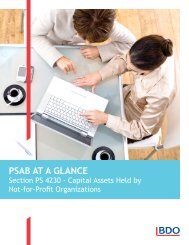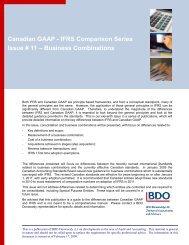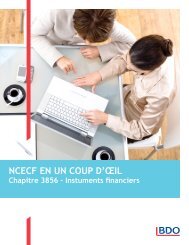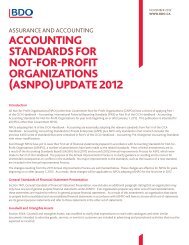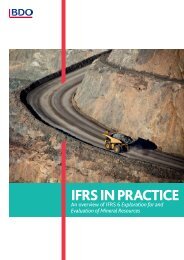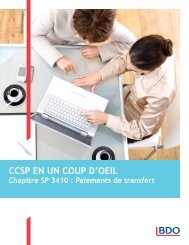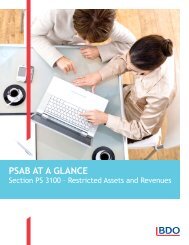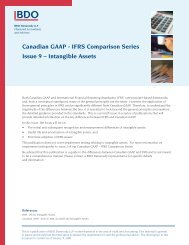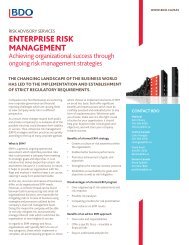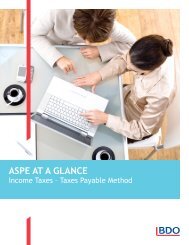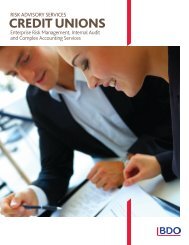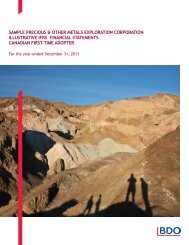Need to Know: IFRS 10 - Consolidated Financial ... - BDO Canada
Need to Know: IFRS 10 - Consolidated Financial ... - BDO Canada
Need to Know: IFRS 10 - Consolidated Financial ... - BDO Canada
- No tags were found...
You also want an ePaper? Increase the reach of your titles
YUMPU automatically turns print PDFs into web optimized ePapers that Google loves.
<strong>IFRS</strong> <strong>10</strong> <strong>Consolidated</strong> <strong>Financial</strong> Statements15The returns of the investee are significantly affected by the management of the investee’s asset portfolio, whichincludes decisions about the selection, acquisition and disposal of the assets within portfolio guidelines and themanagement upon default of any portfolio assets. All those activities are managed by the asset manager untildefaults reach a specified proportion of the portfolio value (ie when the value of the portfolio is such that theequity tranche of the investee has been consumed). From that time, a third-party trustee manages the assetsaccording <strong>to</strong> the instructions of the debt inves<strong>to</strong>r.AssessmentManaging the investee’s asset portfolio is the relevant activity of the investee.The asset manager has the ability <strong>to</strong> direct the relevant activities until defaulted assets reach the specifiedproportion of the portfolio value; the debt inves<strong>to</strong>r has the ability <strong>to</strong> direct the relevant activities when the valueof defaulted assets surpasses that specified proportion of the portfolio value.The asset manager and the debt inves<strong>to</strong>r each need <strong>to</strong> determine whether they are able <strong>to</strong> direct the activitiesthat most significantly affect the investee’s returns, including considering the purpose and design of the investeeas well as each party’s exposure <strong>to</strong> variability of returns.On inception of the structure, it would be expected that the equity tranche would be significant, in order that thedebt holder considered there <strong>to</strong> be little potential for the equity tranche <strong>to</strong> be insufficient <strong>to</strong> absorb anticipatedlosses. Consequently, the asset manager would consolidate the investee.<strong>BDO</strong> commentThis conclusion is different from that which is typically reached under existing guidance. This is because, in applyingSIC-12, it might often be concluded that the asset manager would not consolidate the investment vehicle. This isbecause a 30% holding does not expose the asset manager <strong>to</strong> the majority of the risks and rewards associated with theinvestee. Instead, the investee was created for the benefit of all inves<strong>to</strong>rs and not only for the asset manager.If more than one inves<strong>to</strong>r has power over relevant activities, the inves<strong>to</strong>r that directs the most significant activitieswill have power over an investee under <strong>IFRS</strong> <strong>10</strong>. The significance of an activity is assessed with reference <strong>to</strong> theirpotential <strong>to</strong> affect returns.<strong>BDO</strong> commentFor many investees this criterion in most cases will be straightforward <strong>to</strong> assess. For entities where the power over aninvestee’s relevant activities is shared by multiple inves<strong>to</strong>rs or that have predetermined activities the assessment maybe highly judgmental.<strong>IFRS</strong> <strong>10</strong>.B13 includes an example with two inves<strong>to</strong>rs, one responsible for development and regula<strong>to</strong>ry approval ofmedical product and the other for manufacturing and marketing. The example only provides a list of fac<strong>to</strong>rs thatshould be considered but does not conclude which of the inves<strong>to</strong>rs has control.In addition, care will be required in circumstances in which two or more inves<strong>to</strong>rs appear <strong>to</strong> share control indetermining whether one of the inves<strong>to</strong>rs has control (and therefore applies <strong>IFRS</strong> <strong>10</strong>) or the arrangement instead givesrise <strong>to</strong> joint control (and falls within the scope of <strong>IFRS</strong> 11 Joint Arrangements).



